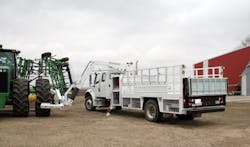Aluminum, fiberglass or steel? When it comes to which material is better for service truck bodies, size matters.
“We actually use all three materials in the tire service truck market,” said Tom Formanek, regional sales manager at Stellar Industries Inc. “Aluminum and fiberglass are primarily used on road service and commercial fleet service trucks. We also use aluminum on farm service trucks. With OTR trucks, primarily steel is being used.”
“Tire service trucks in OTR service tend to face the most rugged work environments, so the durability and strength of steel helps to ensure a longer more productive service life,” said Bill Burns, regional sales manager at Iowa Mold Tooling Co. “Steel also offers a lower cost, which is another benefit for the price-conscious tire dealer.”
The downside to service bodies manufactured with steel is that they are heavier than those manufactured from aluminum. For cost, fiberglass is a more expensive option, but the benefits may make it worth the higher price.
“If you have a low-impact application and plan to keep the truck 10 to 12 years, the savings you get in fuel economy and body life cycle will easily offset the higher up-front cost of the fiberglass body,” said Bob Johnson, director of fleet relations at the National Truck Equipment Association (NTEA).
“If you have a rugged-use application and plan to keep the truck only three to four years — and it’s not in an environment where there are a lot of road salt or corrosion issues — I’m not sure I would want to pay the extra money to get the fiberglass body. Like everything else, it’s about matching the [material] technology with the application.”
“Fiberglass service bodies had several drawbacks that ultimately impacted their demise in the OTR industry,” said Burns. “The most significant drawback for fiberglass was that it became very expensive. In fact, its cost began to offset the cost concerns originally associated with aluminum service bodies, which ultimately led to the adoption of aluminum as the industry standard for one-ton tire service trucks.”
Steel bodies for road service and commercial fleet service trucks were used in the past, but that has evolved into aluminum. Factors such as weight savings, corrosion resistance, longevity and ease of transferring from one chassis to another make steel impractical in those applications.
“Aluminum offers a superior strength-to-weight ratio to steel bodies which allows for a sturdy body, yet light enough to offer a substantial amount of tires and tools,” said Tim Davison, product manager, bodies and cranes, Stellar Industries Inc.
“Aluminum bodies also offer much greater corrosion resistance than steel bodies. In most cases, an aluminum tire service body can be refurbished and mounted from one chassis to another. Steel bodies suffer from road salt corrosion, and also calcium chloride corrosion in farm tire repair.”
[PAGEBREAK]
However, Davison said steel bodies still have their place.
“When looking at an OTR tire repair application, steel bodies still rule,” he said. “Steel bodies are more flexible and superior to aluminum in withstanding rough roads and off-road conditions.”
Davison said fiberglass bodies are an option in tire service bodies only on very small chassis. “Most customers will use this style of body when they only have to haul one or two tires and need to fix a flat on the interstate or do some other form of light fleet service,” said Davison.
Fiberglass has its drawbacks. Fiberglass service trucks cannot be overloaded, and they cannot be used on rough roads, or off-road. Although incredibly light, Davison said fiberglass bodies do not take hard jarring and rough terrain well.
“Aluminum service truck bodies help to keep GVW down, which helps to reduce restrictions on where the trucks can legally and safely operate,” said Burns. “Service truck bodies manufactured with aluminum also offer better corrosion protection. The non-corrosive nature of aluminum makes it an ideal service body material for agricultural applications where calcium is prevalent.”
Burns said another benefit of aluminum is that it can be molded to just about any form.
The ease of forming aluminum enables much more flexibility in the design and build phase of services truck bodies manufactured with it. ■
Corrosion-resistant treatments for steel bodies
One of the downsides of steel, particularly in the Northern U.S. and coastal areas, is its susceptibility to corrosion. However, modern steel truck bodies are often treated with corrosion-resistant coatings that make them better able to stand up to the elements. These treatments include:
Electrocoat (e-coat): A coating method that uses electrical current to deposit paint onto a part or assembled product.
Powder coating: Type of coating applied as a free-flowing, dry powder. The primary difference between a conventional liquid paint and a powder coating is the latter does not require a solvent to keep the binder and filler parts in a liquid suspension form. The coating is typically applied electrostatically, then cured under heat to allow it to flow and form a “skin.” Powder coating generally is used to create a hard finish tougher than conventional paint.
Phosphating: A process in which an acid attacks the steel and re-deposits a material that is a combination of the metal substrate (and other metals, such as zinc) with phosphate. This process creates a surface tightly adherent to the base metal with more surface area, provides improved corrosion inhibition, and helps the powder coating stick better. Phosphating provides a good base coating so the finished part has increased usable life.



